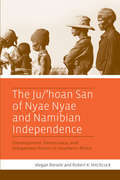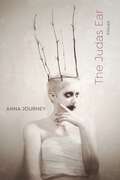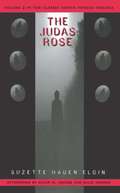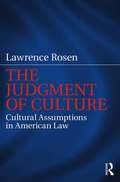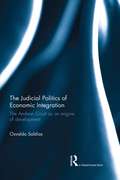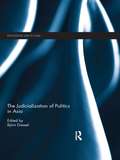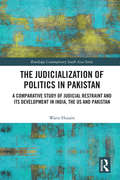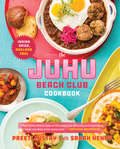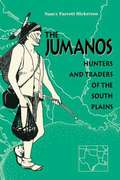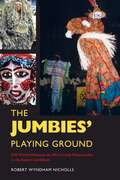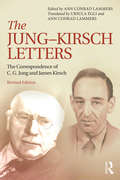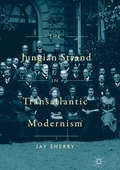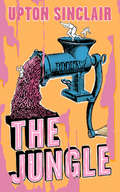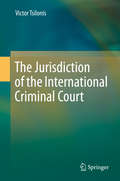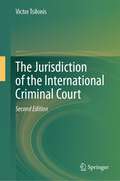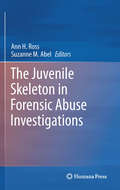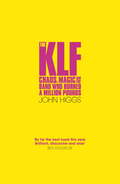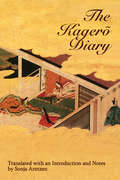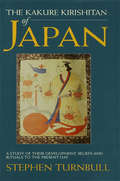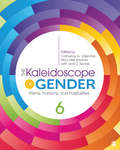- Table View
- List View
The Ju/hoan San Of Nyae Nyae And Namibian Independence: Development, Democracy, and Indigenous Voices in Southern Africa
by Robert K. Hitchcock Megan BieseleThe Ju/'hoan San, or Ju/'hoansi, of Namibia and Botswana are perhaps the most fully described indigenous people in all of anthropology. This is the story of how this group of former hunter-gatherers, speaking an exotic click language, formed a grassroots movement that led them to become a dynamic part of the new nation that grew from the ashes of apartheid South West Africa. While coverage of this group in the writings of Richard Lee, Lorna Marshall, Elizabeth Marshall Thomas, and films by John Marshall includes extensive information on their traditional ways of life, this book continues the story as it has unfolded since 1990. Peopled with accounts of and from contemporary Ju>/'hoan people, the book gives newly-literate Ju/'hoansi the chance to address the world with their own voices. In doing so, the images and myths of the Ju/'hoan and other San (previously called "Bushmen") as either noble savages or helpless victims are discredited. This important book demonstrates the responsiveness of current anthropological advocacy to the aspirations of one of the best-known indigenous societies.
The Judas Ear: Poems
by Anna JourneyAnna Journey’s The Judas Ear resurrects a host of vanished people and places, often through marvelous Ovidian metamorphoses that seem as natural in the gritty tableaux of Richmond, Virginia, as in the luminous shape-shifting vistas of folktale or myth. Journey’s music is lush and visceral, her humor warm and sly, and her sensibility metes out tenderness and grotesquerie in equal parts. Like the ear-shaped mushroom named for a biblical betrayer, the poems in The Judas Ear can shift suddenly from wit to pathos, from seductiveness to danger, with a generosity of vision that is at once wise and revelatory.
The Judas Rose
by Suzette Haden Elgin Julie VedderAn instant cult classic, and groundbreaking forerunner to Margaret Atwood's A Handmaid's Tale. Native Tongue Trilogy revealed to its audiences a frightening future world where the women of Earth are once again property.In Volume II of the trilogy, the women have at last decided to spread the language using the Roman Catholic church. But when a handful of priests discover the plot, they move to stamp it out with their own female agent, Sister Miriam Rose. But Sister Miriam has plans of her own. . . .
The Judgment of Culture: Cultural Assumptions in American Law
by Lawrence RosenLegal systems do not operate in isolation but in complex cultural contexts. This original and thought-provoking volume considers how cultural assumptions are built into American legal decision-making, drawing on a series of case studies to demonstrate the range of ways courts express their understanding of human nature, social relationships, and the sense of orderliness that cultural schemes purport to offer. Unpacking issues such as native heritage, male circumcision, and natural law, Rosen provides fresh insight into socio-legal studies, drawing on his extensive experience as both an anthropologist and a law professional to provide a unique perspective on the important issue of law and cultural practice. The Judgement of Culture will make informative reading for students and scholars of anthropology, law, and related subjects across the social sciences.
The Judicial Politics of Economic Integration: The Andean Court as an Engine of Development
by Osvaldo SaldiasThe Judicial Politics of Economic Integration analyses development strategies and regional integration in the Andean Community (the former Andean Pact), focusing on the establishment of the Andean Court of Justice and its case law, as well as the intellectual underpinnings that made such an impressive reform possible. The court is a transplant taken from the European integration process, and it materializes the visions, expectations, and dreams of the transnational development movement of "integration through law". The book discusses the outcomes of the Court in light of the debates about judicial reform in the process of development and regional integration. Although clearly confirming several earlier claims that "one size does not fit all", Osvaldo Saldias provides new insights into how legal transplants adapt and evolve, and how we can learn much more about legal reform from a project that presumably failed than from successful copies. The Andean Court of Justice is a remarkable example of an institution capable of adapting to political and economic challenges; therefore, in times of a severe European economic crisis we should not forget that we might improve our understanding of European integration by looking at developments in other regions. An interesting new study with an international focus, this book will be a fascinating read for students and scholars of Law and Latin American Studies.
The Judicialization of Politics in Asia (Routledge Law in Asia)
by Bjö DresselOver the last two decades courts have become major players in the political landscape in Asia. This book assesses what is driving this apparent trend toward judicialization in the region. It looks at the variations within the judicialization trend, and how these variations affect political practice and policy outcomes. The book goes on to examine how this new trend is affecting aspects of the rule of law, democratic governance and state-society relations. It investigates how the experiences in Asia add to the debate on the judicialization of politics globally; in particular how judicial behaviour in Asia differs from that in the West, and the implications of the differences on the theoretical debate.
The Judicialization of Politics in Pakistan: A Comparative Study of Judicial Restraint and its Development in India, the US and Pakistan (Routledge Contemporary South Asia Series)
by Waris HusainSince 2007, the Supreme Court of Pakistan has emerged as a dominant force in Pakistani politics through its hyper-active use of judicial review, or the power to overrule Parliament’s laws and the Prime Minister’s acts. This hyper-activism was on display during the Supreme Court’s unilateral disqualification of Prime Minister Yousef Raza Gilani in 2012 under the leadership of Chief Justice Iftikhar Chaudhry. Despite the Supreme Court’s practical adoption of restraint subsequent to the retirement of Chief Justice Chaudhry in 2013, the Court has once again disqualified a prime minister, Nawaz Sharif, due to allegations of corruption in 2017. While many critics have focused on the substance of the Court’s decisions in these cases, sufficient focus is not paid to the amorphous case-selection process of the Supreme Court of Pakistan. In order to compare the relatively unregulated process of case-selection in Pakistan to the more structured processes utilized by the Supreme Courts of the United States’ and India, this book aims to understand the historical roots of judicial review in each country dating back to the colonial era extending through the foundational period of each nation impacting present-day jurisprudence. As a first in its kind, this study comparatively examines these periods of history in order to contextualize a practical prescription to standardize the case-selection process in the Supreme Court of Pakistan in a way that retains the Court’s overall power while limiting its involvement in purely political issues. This publication offers a critical and comparative view of the Supreme Court of Pakistan’s recent involvement in political disputes due to the lack of a discerning case-selection system that has otherwise been adopted by the Supreme Courts of India and the United States’ to varying degrees. It will be of interest to academics in the fields of Asian Law, South Asian Politics and Law and Comparative Law.
The Juhu Beach Club Cookbook: Indian Spice, Oakland Soul
by Preeti Mistry Sarah Henry"What Preeti Mistry does on the page is as delicious and exciting as what she does in her restaurant." - Anthony BourdainVibrant and unexpected, The Juhu Beach Club Cookbook is a bold take on Indian food from Oakland-based James Beard Award nominee Preeti Mistry.Influenced by her background as a second-generation Indian -- born in London, raised across the US, now based in the Bay Area -- Preeti's irreverent style informs her personality and her food. This collection of street food, comfort classics, and restaurant favorites blends cuisines from across India with American influences to create irresistible combinations. Organized by feeling rather than course or season, with chapters like Masala Mashups, Farm Fresh, and Authentic? Hell Yeah, The Juhu Beach Club Cookbook weaves Preeti's culinary journey together with more than 100 bold, flavor-forward recipes to excite and inspire home cooks. Illustrated throughout with full-color photography and playful line art, this book captures the eclectic energy and wide-ranging influences of one of the West Coast's most up-and-coming chefs.
The Jumanos: Hunters and Traders of the South Plains
by Nancy Parrott HickersonIn the late sixteenth century, Spanish explorers described encounters with North American people they called "Jumanos." Although widespread contact with Jumanos is evident in accounts of exploration and colonization in New Mexico, Texas, and adjacent regions, their scattered distribution and scant documentation have led to long-standing disagreements: was "Jumano" simply a generic name loosely applied to a number of tribes, or were they an authentic, vanished people?<P><P>In the first full-length study of the Jumanos, anthropologist Nancy Hickerson proposes that they were indeed a distinctive tribe, their wide travel pattern linked over well-established itineraries. Drawing on extensive primary sources, Hickerson also explores their crucial role as traders in a network extending from the Rio Grande to the Caddoan tribes' confederacies of East Texas and Oklahoma.
The Jumbies' Playing Ground: Old World Influences on Afro-Creole Masquerades in the Eastern Caribbean (Folklore Studies in a Multicultural World Series)
by Robert Wyndham NichollsDuring the masquerades common during carnival time, jumbies (ghosts or ancestral spirits) are set free to roam the streets of Caribbean nations, turning the world topsy-turvy. Modern carnivals, which evolved from earlier ritual celebrations featuring disguised performers, are important cultural andeconomic events throughout the Caribbean, a direct link to a multilayered history.This work explores the evolutionary connections in function, garb, and behavior between Afro-Creole masquerades and precursors from West Africa, the British Isles, and Western Europe. Robert Wyndham Nicholls utilizes a concept of play derived from Africa to describe a range of lighthearted and ritualistic activities. Along with Old World seeds, he studies the evolution of Afro- Creole prototypes that emerged in the Eastern Caribbean--bush masquerades, stilt dancers, animal disguises, she-males, female masquerades, and carnival clowns. Masquerades enact social, political, and spiritual roles within recurring festivals, initiations, wakes, skimmingtons, and weddings. The author explores performance in terms of abstraction in costume-disguise and the aesthetics of music, songs, drum rhythms, dance, and licentiousness. He reveals masquerades as transformative agent, ancestral endorser, behavior manager, informal educator, and luck conferrer.
The Jung-Kirsch Letters: The Correspondence of C.G. Jung and James Kirsch
by Ann Conrad LammersThis book charts Carl Gustav Jung’s 33-year (1928-61) correspondence with James Kirsch, adding depth and complexity to the previously published record of the early Jungian movement. Kirsch was a German-Jewish psychiatrist, a first-generation follower of Jung, who founded Jungian communities in Berlin, Tel Aviv, London, and Los Angeles. Their letters tell of heroic survival, brilliant creativity, and the building of generative institutions, but these themes are darkened by personal and collective shadows. The Nazi era looms over the first half of the book, shaping the story in ways that were fateful not only for Kirsch and his career but also for Jung and his. Kirsch trained with Jung and acted as a tutor in Jewish psychology and culture to him. In 1934, fearing that anti-Semitism had seized his teacher, Kirsch challenged Jung to explain some of his publications for the Nazi-dominated Medical Society for Psychotherapy. Jung’s answer convinced Kirsch of his sincerity, and from then on Kirsch defended him fiercely against any allegation of anti-Semitism. We also witness Kirsch’s lifelong struggle with states of archetypal possession: his identification with the interior God-image on the one hand, and with unconscious feminine aspects of his psyche on the other. These complexes were expressed, for Kirsch, in physical symptoms and emotional dilemmas, and they led him into clinical boundary violations which were costly to his analysands, his family and himself. The text of these historical documents is translated with great attention to style and accuracy, and generous editorial scaffolding gives glimpses into the writers’ world. Four appendices are included: two essays by Kirsch, a series of letters between Hilde Kirsch and Jung, and a brief, incisive essay on the Medical Society for Psychotherapy. This revised edition includes primary material that was unavailable when the book was first published, as well as updated footnotes and minor corrections to the translated letters.
The Jungian Strand in Transatlantic Modernism
by Jay SherryIn studies of psychology’s role in modernism, Carl Jung is usually relegated to a cameo appearance, if he appears at all. This book rethinks his place in modernist culture during its formative years, mapping Jung’s influence on a surprisingly vast transatlantic network of artists, writers, and thinkers. Jay Sherry sheds light on how this network grew and how Jung applied his unique view of the image-making capacity of the psyche to interpret such modernist icons as James Joyce and Pablo Picasso. His ambition to bridge the divide between the natural and human sciences resulted in a body of work that attracted a cohort of feminists and progressives involved in modern art, early childhood education, dance, and theater.
The Jungle
by Upton Sinclair Eric Schlosser Jonathan Beecher Field Ronald GottesmanUpton Sinclair's dramatic and deeply moving story exposed the brutal conditions in the Chicago stockyards at the turn of the nineteenth century and brought into sharp moral focus the appalling odds against which immigrants and other working people struggled for their share of the American dream. Denounced by the conservative press as an un-American libel on the meatpacking industry, the book was championed by more progressive thinkers, including then President Theodore Roosevelt, and was a major catalyst to the passing of the Pure Food and Meat Inspection act, which has tremendous impact to this day.Enriched eBook Features Editor Jonathan Beecher Field provides the following specially commissioned features for this Enriched eBook Classic:* Chronology* Filmography (and the 1914 The Jungle Film Poster)* Early Twentieth-Century Reviews of The Jungle* Suggestions for Further Reading* The Jungle and the Pure Food and Drug Act of 1906* The Jungle Book Cover Designs* Federal Food and Drugs Act of 1906* Immigrants and the Meatpacking Industry, Then and Now* Images of the Chicago Stockyards* Images of Cuts of Beef and Pork* Enriched eBook NotesThe enriched eBook format invites readers to go beyond the pages of these beloved works and gain more insight into the life and times of an author and the period in which the book was originally written for a rich reading experience.
The Jungle (Dover Thrift Editions Series)
by Upton SinclairUpton Sinclair's dramatic and deeply moving story exposed the brutal conditions in the Chicago stockyards at the turn of the nineteenth century and brought into sharp moral focus the apalling odds against which immigrants and other working people struggled for their share of the American dream. Denounced by the conservative press as an un-American libel on the meatpacking industry, The Jungle was championed by more progressive thinkers, including then president Theodore Roosevelt, and was a major catalyst to the passing of the Pure Food and Meat Inspection act, which has tremendous impact to this day.Penguin Random House Canada is proud to bring you classic works of literature in e-book form, with the highest quality production values. Find more today and rediscover books you never knew you loved.
The Jurisdiction of the International Criminal Court
by Victor TsilonisThe book provides a holistic examination of the jurisdiction of the International Criminal Court (ICC). The main focus is placed on the three pillars which form the ICC’s foundation pursuant to the Rome Statute:the preconditions to the exercise of its jurisdiction (Article 12 Rome Statute)the substantive competence, i.e. the core crimes (Article 5-8bis Rome Statute, i.e. genocide, crimes against humanity, war crimes, crime of aggression) the principle of complementarity (Article 17§1 (a) Rome Statute) The latter governs the ICC's ‘ultimate jurisdiction’, since it is not merely sufficient for a crime to be within the Court's jurisdiction (according to the substantive, geographical, personal and temporal jurisdictional criteria), but the State Party must also be unwilling or unable genuinely to carry out the investigation or prosecution. Finally yet importantly, the main ‘negative preconditions’ for the Court’s jurisdiction, i.e. immunities (Article 27 Rome Statute) and exceptions via Security Council referrals are thoroughly examined.The book is an excellent resource for scholars as well as practitioners and notably contributes to the existing literature.
The Jurisdiction of the International Criminal Court
by Victor TsilonisThis book embarks on a comprehensive exploration of the jurisdiction of the International Criminal Court (ICC) and elucidates the three foundational aspects of its jurisdiction as laid out in the Rome Statute: the preconditions for exercising jurisdiction (Article 12 ICCRSt), its substantive competence regarding core crimes (Articles 5-8bis ICCRSt), and the principle of complementarity (Article 17§1(a) ICCRSt).This principle, crucial to understanding the ICC’s ‘ultimate jurisdiction’, is invoked only when a State Party demonstrates an inability or unwillingness to genuinely undertake investigation or prosecution. The book further probes the ‘negative preconditions’ of the Court’s jurisdiction, in particular, immunities (Article 27 ICCRSt) and exceptions through Security Council referrals (Articles 13(b) and 15 ICCRSt).Intended for students, scholars, and practitioners alike, this second edition offers invaluable insights into the ICC’s jurisdiction, making a notable contribution to the existing literature. Importantly, it also navigates emerging fields of international criminal law, addressing topical and thought-provoking subjects such as ecocide, cyber warfare, automated lethal weapons, artificial intelligence, and the legal complexities arising from the Russian invasion of Ukraine.
The Justice Calling: Where Passion Meets Perseverance
by Mark Labberton Bethany Hanke Hoang Kristen Deede JohnsonJustice requires perseverance--a deep perseverance we can't muster on our own. The world's needs are staggering and even the most passion-driven reactions, strategies, and good intentions can falter. But we serve a God who never falters, who sees the needs, hears the cries, and gives strength--through Jesus Christ and the Holy Spirit--to his people. Offering a comprehensive biblical theology of justice drawn from the whole story of Scripture, this book invites us to know more intimately the God who loves justice and calls us to give our lives to seek the flourishing of others. The authors explore stories of injustice around the globe today and spur Christians to root their passion for justice in the persevering hope of Christ. They also offer practices that can further form us into people who join God's work of setting things right in the world. Now in paper with an added reader's guide.
The Justification of Responsibility in the UN Security Council: Practices of Normative Ordering in International Relations (Routledge Global Cooperation Series)
by Holger NiemannThe UN Security Council has been given the primary responsibility for maintaining international peace and security. The precise meaning of this responsibility, however, is contested. This lack of clarity is frequently criticised as a source of incoherent and selective decision-making, undermining the legitimacy of the Security Council. In case studies of the Security Council’s controversies on Iraq and Syria, this book instead reveals contestation and competing interpretations of responsibility as crucial conditions for the constitution and negotiation of normative order. The case studies also underline the importance of public Security Council meetings as dynamic sites for coping with a plurality of normative orders and how their symbolic and material manifestations shape processes of collective legitimation. This book concludes that these processes demonstrate the crucial role of justification and critique as practices of normative ordering in the Security Council.The Justification of Responsibility in the UN Security Council argues that normative orders in international organisations are constructed by multifaceted processes of questioning, reaffirming and coordinating claims of normativity and legitimacy. Connecting research on norms and legitimacy in international relations with pragmatist sociology, the book provides an account of the complexities and inconsistencies of decision-making processes and their normative foundations in international organisations. This book will be of interest to scholars and students of international organisations, international relations theory and global governance.
The Juvenile Skeleton in Forensic Abuse Investigations
by Ann H. Ross Suzanne M. AbelJuvenile homicide and fatal maltreatment remain serious and pervasive problems in the developed world and especially in the United States, where in 2005 some 1,500 children died from neglect and physical abuse. Alarming statistics such as this, as well as an upsurge in the media attention paid to all things forensic, underscore the pressing need for the utmost rigor in the scientific investigation of child abuse cases. This well timed volume is a response to the climate of public and press interest in such inquiries, where the forensic aspects of the casework generate an enormous amount of attention. The contributions cover a wide range of topics and explore many of the finer details of investigations into juvenile fatalities suspected of being abuse-related. The chapters reflect both the multi-disciplinary nature of such investigations, and also the need for law enforcement professionals to take a rounded, holistic approach to the casework involved. The motivational factors that lead many professionals enter this arena of investigation are, of course, personal and individual. However, at the core of their commitment and their work is a shared need for justice, plain and simple. Victim advocacy and protecting the rights of children, both living and deceased, remains a key impetus for those professionals who specialize in child abuse research. At the heart of this book is the aim of providing both a vital resource for investigators, and a purposeful voice for the young victims of abuse, unable as they are to stand up and speak for themselves.
The KLF: Chaos, Magic and the Band who Burned a Million Pounds
by John Higgs'By far the best book this year, brilliant, discursive and wise' BEN GOLDACRE. The strange tale of the death, life and legacy of the hugely successful band.They were the bestselling singles band in the world. They had awards, credibility, commercial success and creative freedom. Then they deleted their records, erased themselves from musical history and burnt their last million pounds in a boathouse on the Isle of Jura. And they couldn't say why.This is not just the story of The KLF. It is a book about Carl Jung, Alan Moore, Robert Anton Wilson, Ken Campbell, Dada, Situationism, Discordianism, magic, chaos, punk, rave, the alchemical symbolism of Doctor Who and the special power of the number 23.Wildly unauthorised and unlike any other music biography, THE KLF is a trawl through chaos on the trail of a beautiful, accidental mythology.
The Kagero Diary: A Woman’s Autobiographical Text from Tenth-Century Japan (Michigan Monograph Series in Japanese Studies #19)
by Sonja ArntzenJapan is the only country in the world where women writers laid the foundations of classical literature. The Kagero Diary commands our attention as the first extant work of that rich and brilliant tradition. The author, known to posterity as Michitsuna’s Mother, a member of the middle-ranking aristocracy of the Heian period (794–1185), wrote an account of 20 years of her life (from 954–74), and this autobiographical text now gives readers access to a woman’s experience of a thousand years ago. The diary centers on the author’s relationship with her husband, Fujiwara Kaneie, her kinsman from a more powerful and prestigious branch of the family than her own. Their marriage ended in divorce, and one of the author’s intentions seems to have been to write an anti-romance, one that could be subtitled, “I married the prince but we did not live happily ever after.” Yet, particularly in the first part of the diary, Michitsuna’s Mother is drawn to record those events and moments when the marriage did live up to a romantic ideal fostered by the Japanese tradition of love poetry. At the same time, she also seems to seek the freedom to live and write outside the romance myth and without a husband. Since the author was by inclination and talent a poet and lived in a time when poetry was a part of everyday social intercourse, her account of her life is shaped by a lyrical consciousness. The poems she records are crystalline moments of awareness that vividly recall the past. This new translation of the Kagero Diary conveys the long, fluid sentences, the complex polyphony of voices, and the floating temporality of the original. It also pays careful attention to the poems of the text, rendering as much as possible their complex imagery and open-ended quality. The translation is accompanied by running notes on facing pages and an introduction that places the work within the context of contemporary discussions regarding feminist literature and the genre of autobiography and provides detailed historical information and a description of the stylistic qualities of the text.
The Kakure Kirishitan of Japan: A Study of Their Development, Beliefs and Rituals to the Present Day
by Stephen TurnbullFirst major study in English of the Japanese 'hidden' Christians - the Kakure Kirishitan, who chose to remain separate from the Catholic Church when religious toleration was granted in 1873 - and the development of the faith and rituals from the 16th century to the present day.
The Kakure Kirishitan of Japan: A Study of Their Development, Beliefs and Rituals to the Present Day
by Stephen TurnbullFirst major study in English of the Japanese 'hidden' Christians - the Kakure Kirishitan, who chose to remain separate from the Catholic Church when religious toleration was granted in 1873 - and the development of the faith and rituals from the 16th century to the present day.
The Kaleidoscope of Gender: Prisms, Patterns, and Possibilities
by Joan Z. Spade Mary Nell Trautner Catherine Kay ValentineThe Kaleidoscope of Gender: Prisms, Patterns, and Possibilities provides an accessible, timely, and stimulating overview of the cutting-edge literature and theoretical frameworks in sociology and related fields in order to understand the social construction of gender. The kaleidoscope metaphor and its three themes—prisms, patterns, and possibilities—unify topic areas throughout the book. By focusing on the prisms through which gender is shaped, the patterns which gender takes, and the possibilities for social change, the reader gains a deeper understanding of ourselves and our relationships with others, both locally and globally. Editors Catherine Valentine, Mary Nell Trautner and the work of Joan Spade focus on the paradigms and approaches to gender studies that are constantly changing and evolving. The Sixth Edition includes incorporation of increased emphasis on global perspectives, updated contemporary social movements, such as #BlackLivesMatter and #MeToo, and an updated focus on gendered violence.
The Kaleidoscope of Gender: Prisms, Patterns, and Possibilities
by Joan Z. Spade Mary Nell Trautner Catherine Kay ValentineThe Kaleidoscope of Gender: Prisms, Patterns, and Possibilities provides an accessible, timely, and stimulating overview of the cutting-edge literature and theoretical frameworks in sociology and related fields in order to understand the social construction of gender. The kaleidoscope metaphor and its three themes—prisms, patterns, and possibilities—unify topic areas throughout the book. By focusing on the prisms through which gender is shaped, the patterns which gender takes, and the possibilities for social change, the reader gains a deeper understanding of ourselves and our relationships with others, both locally and globally. Editors Catherine Valentine, Mary Nell Trautner and the work of Joan Spade focus on the paradigms and approaches to gender studies that are constantly changing and evolving. The Sixth Edition includes incorporation of increased emphasis on global perspectives, updated contemporary social movements, such as #BlackLivesMatter and #MeToo, and an updated focus on gendered violence.
